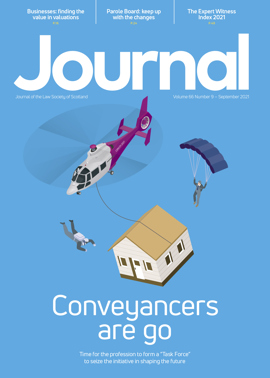Agriculture: Crofting disputes: some first principles
Below I discuss two recent crofting cases of interest, both from the Land Court.
Macleod v MacLean
In Macleod v MacLean (SLC/65/19), the applicant challenged the first registration of a croft in Stornoway. The crofts concerned (21A and 21B Sheshader) were created in 1946 by written agreement dividing croft “21 Sheshader” into two separate holdings. The applicant became tenant of croft 21A by virtue of his father-in-law renouncing tenancy in his favour; the respondent was assigned the tenancy of croft 21B by his mother.
The crofts are bisected by a single track public road. The disputed area related to the south eastern boundary, which the applicant argued should be a straight line from road to sea, not the registered position which included a kink in the fenceline which had been in place since the 1940s, providing the respondent with an additional triangular section of land. Although not raised as an issue until 2017, the applicant contended that he had always considered the disputed area to be part of his croft. The court made clear that such a delay in raising this complaint would not necessarily be detrimental to the applicant if the evidence supported his position, noting that “neither prescription- nor personal bar-based arguments [hold] any sway in this crofting context” (para 22).
Evidence by both parties was considered together with documentation from the court archives. The court seemed to deem the historic estate plan of the croft as most persuasive, together with archive evidence indicating that the estate plans had been used in the past to assist in determining croft boundaries. It also noted that the respondent’s case lacked “any convincing explanation as to why… the line of the boundary should, approaching the public road, have deviated from the straight in the manner the respondent claims it did. When a croft is being fenced, the general rule is the fewer changes of direction, the better” (para 31).
The court therefore found for the applicant, stating that on balance of probabilities, the boundary continued in the straight line from the sea to the road. It directed that the boundaries be modified by removing the disputed area from the registered croft 21B Sheshader. This case acts as a stark reminder that first registration of a croft may unearth longstanding disputes between neighbours and, unlike the Land Register, beating a neighbour to the Crofting Register does not necessarily dictate which party has the upper hand.
Macdonald v Kennedy
Macdonald v Kennedy (SLC/75/20) examined the process followed by the Crofting Commission in terminating a croft tenancy. The applicant landlord had long intended to retire to the croft, and leased it to a friend on the understanding that the friend would vacate when the landlord retired. Unfortunately the tenant died in May 2016. The Commission wrote to the landlord in December 2018 advising that it planned to “terminate the tenancy and declare the croft vacant”. The landlord failed to make representations in response, and as a result the Commission sent written notice of the termination and vacancy of the croft with immediate effect, per s 11(8) of the Crofters (Scotland) Act 1993.
In response, the landlord’s solicitor wrote to the Commission suggesting that the croft was not to be relet but instead split into two holdings, and sold thereafter. This was not a competent suggestion as, under s 9 of the Act, only a crofter (not a landlord) may apply to divide a croft. The landlord’s preference to sell rather than relet led to no representation being made in response to the Commission’s notice, and ultimately the mandatory provisions in s 23(5A)-(5C) were triggered and the Commission publicly invited applications for the tenancy. The landlord’s solicitor also made no suggestions as to rent, and the Commission ultimately advised that the rent had been fixed at £18 per annum and a new tenant found (the respondent).
The landlord applied to the court under s 23(6) of the Act for variation of the terms and conditions of let fixed by the Commission, on the basis that the fixed conditions would cause “unreasonable prejudice to the applicant in terms of preventing him retiring to live on the croft and cultivate it”, and that he would ultimately be deprived of use of the croft if the tenant exercised a right to buy. The respondent argued that it would be incompetent by s 5(1) of the Act for a landlord to let out a croft on any conditions other than those set out in the statute and fixed by the Commission. In addition, the variation sought would be inconsistent with the key principles of crofting legislation which seek to provide security of tenure to crofters.
The court found for the respondent, acknowledging (para 24) that the landlord “did not appear to take advantage” of his opportunities to respond to the Commission throughout the reletting process. It agreed that the Commission was bound by the conditions of let set out in the Act and, in any case, the modifications sought would have been “contrary to the whole of the crofting legislation” (para 27), and would likely have gone beyond what was intended by Parliament (para 29). Despite the purpose of s 23(6) being to protect the landlord, in reality it seems the landlord will rarely prevail in crofting disputes.
Regulars
Perspectives
Features
Briefings
- Civil court: Legacy of COVID
- Corporate: The enigma of economic duress
- Employment: where will work be found?
- Intellectual property: David v Goliath battle continues
- Agriculture: Crofting disputes: some first principles
- Sport: Arbitration – within the rules?
- Property: ADS: the hidden traps
- In-house: On harm, stakeholders and risk management
In practice
- Ask Ash: Colleague's chat is my privacy
- Lockdown no more
- The Word of Gold: The potency of passion
- Get interactive at the Law and Technology Conference
- Ten red flags for conveyancers
- The Eternal Optimist: So, what do you want to be?
- Commissary: the top 10 failings
- Mobility challenges – and the kindness of strangers
- When all is remote







